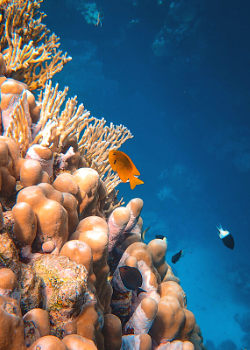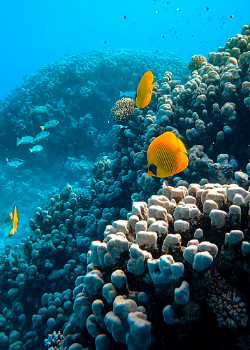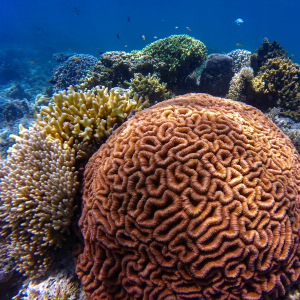 Thanks to the diligent care taken by the aquarists on our Ectotherm team, your Akron Zoo has been home to various species of coral and seen significant growth in our coral colonies over the last decade. Coral are extremely sensitive to their environment, both in their native habitat and in human care, so we spend countless hours monitoring their water chemistry, lighting and water flow, and adjusting their habitats accordingly. Because of the delicate nature of coral reefs and the diverse ecosystems they provide, the Association of Zoos and Aquariums (AZA) is making great efforts to save the largest barrier reef in the Continental U.S., the Florida Reef Tract, from the perils it faces.
Thanks to the diligent care taken by the aquarists on our Ectotherm team, your Akron Zoo has been home to various species of coral and seen significant growth in our coral colonies over the last decade. Coral are extremely sensitive to their environment, both in their native habitat and in human care, so we spend countless hours monitoring their water chemistry, lighting and water flow, and adjusting their habitats accordingly. Because of the delicate nature of coral reefs and the diverse ecosystems they provide, the Association of Zoos and Aquariums (AZA) is making great efforts to save the largest barrier reef in the Continental U.S., the Florida Reef Tract, from the perils it faces.
Most people are surprised to learn that corals are animals rather than plants. They are made up of thousands of tiny animals called polyps, who each have a stomach, mouth, and tiny tentacles to grab food. Though their bodies are squishy, polyps are able to use calcium found in the natural seawater around them to build a hard outer shell, creating a skeletal structure which sticks to the sea floor or other polyps. This forms the coral shapes you are likely familiar with. As coral grow older, new polyps are born and attach to the skeletal structure, making it larger. Some coral species who have been building their skeletons slowly over thousands of years form what we know as coral reefs.
 Sadly, corals throughout the world’s oceans are facing several dangers that threaten their survival. The Caribbean coral, for example, are currently facing a new and relatively unknown disease named Stony-Coral Tissue Loss Disease (SCTLD). The pathogen and its mode of transmission have not yet been identified, but scientists are working diligently to find the disease and a possible treatment. The devastating disease affects several species of coal and causes lesions that result in tissue loss and eventual death. Today, SCTLD has caused between 50% - 90% die off in many coral species along the Florida Reef Tract, depending on their susceptibility.
Sadly, corals throughout the world’s oceans are facing several dangers that threaten their survival. The Caribbean coral, for example, are currently facing a new and relatively unknown disease named Stony-Coral Tissue Loss Disease (SCTLD). The pathogen and its mode of transmission have not yet been identified, but scientists are working diligently to find the disease and a possible treatment. The devastating disease affects several species of coal and causes lesions that result in tissue loss and eventual death. Today, SCTLD has caused between 50% - 90% die off in many coral species along the Florida Reef Tract, depending on their susceptibility.
Drastic times call for drastic measures, and many members of the Association of Zoos and Aquariums (AZA) have banded together to form the AZA Florida Reef Tract Rescue Project (FRTRP) to combat this disease. The Rescue Team is working hand in hand with government agencies such as NOAA Fisheries Services and the Florida Department of Environmental Protection to save what is left of the affected corals in the area. The goal is to house and maintain 5,000 coral fragments in biosecure locations as a hold over until the disease can be better understood and managed. These corals will be propagated in human care, in the hope that they can someday be returned to their native habitat and used to restore the coral reef in the future.
 Such lofty conservation goals can only be reached through your continued support for zoos and aquariums as we strive to improve our husbandry and care practices for coral species in our care. While the Akron Zoo doesn’t currently hold any biosecure fragments from the Florida Reef Tract, we are professional affiliates (or “Friends” as the program calls it) of the FRTRP project, and we continue to care for several other species of coral to help maintain a genetically diverse population in our zoo and in the AZA. Together we can save this beautiful, diverse, and ecologically significant coral reef and prevent our own “American Barrier Reef” from becoming functionally extinct.
Such lofty conservation goals can only be reached through your continued support for zoos and aquariums as we strive to improve our husbandry and care practices for coral species in our care. While the Akron Zoo doesn’t currently hold any biosecure fragments from the Florida Reef Tract, we are professional affiliates (or “Friends” as the program calls it) of the FRTRP project, and we continue to care for several other species of coral to help maintain a genetically diverse population in our zoo and in the AZA. Together we can save this beautiful, diverse, and ecologically significant coral reef and prevent our own “American Barrier Reef” from becoming functionally extinct.
